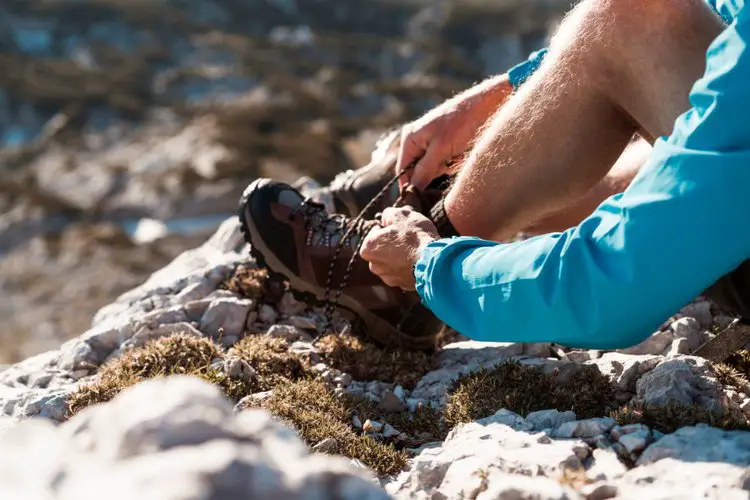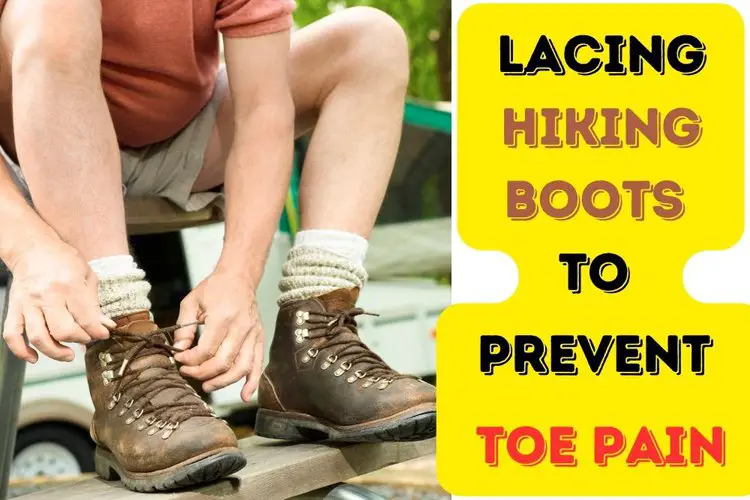Hiking can be an enjoyable experience, but it can quickly turn painful if your boots are not laced correctly.
Toe pain is a common issue when hiking, but fortunately, there are several lacing techniques you can use to alleviate this problem.
In this article, we will introduce five effective lacing techniques for hiking boots: straight bar lacing, loop lacing, window lacing, wide feet lacing, and toe cap lacing.
We’ll explain how each technique works and who they are suitable for.
Key Takeaways
- Straight bar lacing, loop lacing, window lacing, wide feet lacing, and toe cap lacing are all effective methods to prevent toe pain in hiking boots.
- Experiment with different lacing techniques to find the one that works best for you, and don’t be afraid to adjust the tension when needed.
- Make sure your boots fit properly and are broken in before attempting any lacing techniques.

Toe pain when wearing hiking boots can be caused by a variety of factors, and one of the most common causes is improper lacing.
When lacing your boots incorrectly, you can put too much pressure on your toes or create uncomfortable rubbing and friction that can lead to blisters and pain.
Some common lacing mistakes that can cause toe pain include tying the laces too tightly, tying the laces too loosely, or tying the laces in a way that doesn’t distribute even pressure on the feet.
It’s essential to learn proper lacing techniques to avoid these mistakes and reduce the risk of toe pain when hiking. Below are some lacing techniques that can help you achieve a more comfortable fit and avoid unnecessary pressure on your toes.
Contents
Straight Bar Lacing
The straight bar lacing technique is a simple and effective way to relieve pressure on your toes. The technique aims at lacing your boots in a straight line, like a ladder, without crossing the laces over each other.
This allows you to adjust the tightness of the laces on each side separately so that you don’t bundle up too much stress on your toes.
Straight bar lacing is suitable for people with wider feet or those who want more room in the toe box.
Here’s how to do straight bar lacing:
Window Lacing
Window lacing is a technique that creates a window in the middle of your laces, which can relieve pressure on the top of your foot.
It involves skipping one or two eyelets in the middle of the boot (near the toe box as possible) and lacing up the rest of the eyelets as usual. This creates a gap in the laces that can reduce pressure on the top of your foot.
This technique is suitable for people who experience pressure on the top of their feet.
Check out the video below to see you do it:
Toe Cap Lacing
Toe cap lacing is a technique that relieves pressure on the big toe by creating a separate lacing section for the toe box.
This lacing technique works by pulling the laces up and away from the toes, creating a small pocket of space around the toe cap of the boot.
This small pocket of space allows for the toes to move and flex without being restricted or squeezed, reducing the pressure on the toes and preventing pain.
This method can be used by anyone who experiences toe pain in their hiking boots and is looking for a quick and easy solution.
Here’s how you do it:
Loop Lacing
This is a method to keep your boots fit snugly around the top of the foot and the ankle. It is especially helpful for mid or high-cut hiking boots.
You can choose one of the lacing methods above and remember to keep the laces loose around the toe box to reduce the stress on your toes. Then finish it with the loop lacing technique to keep your foot in place and not move inside the boots, preventing the toes from hitting the tip of your hiking boots.
Loop lacing involves creating small loops in the laces. Combined with the above techniques, you can reduce pressure on the toe area and your whole foot.
This technique is ideal for those with high arches or who need more room in the midfoot.
Here are some tips and notes to prevent toe pain while lacing your hiking boots:
- The laces should be loose around the toe box and tight on top of the foot or ankle to keep the boot stay on your foot
- Experiment with different lacing techniques to find the one that works best for you
- Customize the fit of your boots to alleviate pressure on certain parts of your feet
- Don’t overtighten the laces, as it can cause unnecessary pressure on your toes
- Wear socks that provide cushioning and support in the toe area, and avoid cotton socks
- Ensure that your boots fit correctly by measuring your feet and trying on boots with different lacing techniques
- Take breaks to let your feet rest, which can help prevent toe pain and other foot problems.
Conclusion
In summary, there are several effective lacing techniques for hiking boots that can help alleviate toe pain.
If you have wide feet, consider doing straight bar lacing for an easily customizable fit. For those who often experience pressure on the top of their foot, window lacing is suitable for you.
Meanwhile, toe cap lacing is perfect for those who want to reduce stress in the big toe.
To tie the laces, you can use loop lacing. It is ideal for relieving pain in the entire foot when combined with other mentioned techniques.
Experiment with these techniques to find the one that works best for you, and enjoy your next hike without worrying about painful toes!

